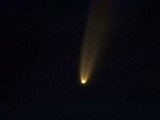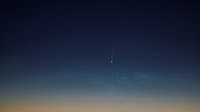नव-धूमकेतु ( C / 2020 F3 )
 C/2020 F3 (NEOWISE) photographed from France on July 13, 2020 | |
| आविष्कार | |
|---|---|
| आविष्कारकर्त्ता | NEOWISE |
| आविष्कार दिनांक | March 27, 2020[1] |
| कक्षीय गुणधर्म[ A] | |
| युग | 2458953.5 (April 14, 2020) |
| अपसौर | 544 AU (inbound) 720 AU (outbound) |
| उपसौर | 0.29478 AU |
| अर्ध दीर्घ अक्ष | 272 AU (inbound) 360 AU (outbound) |
| उत्केन्द्रता | 0.99921 |
| कक्षीय अवधि | ~4500 yrs (inbound)[2] ~6800 yrs (outbound) |
| आनति | 128.93° |
| पूर्व उपसौर | July 3, 2020 |
C / 2020 F3 (NEOWISE) , या धूमकेतु NEOWISE एक प्रतिगामी धूमकेतु है | जो 27 मार्च, 2020 को एक निकट-परवलयिक कक्षा के साथ खोजा गया था, जो NEOWISE स्पेस टेलीस्कोप का उपयोग करके खगोलविदों द्वारा किया गया था। उस समय, यह 10 वाँ परिमाण वाला धूमकेतु था, जो सूर्य से 2 AU (300 मिलियन किमी ; 190 मिलियन मील ) दूर और पृथ्वी से 1.7 AU (250 मिलियन किमी; 160 मिलियन मील) दूर था। [3]
जुलाई 2020 तक, यह पर्याप्त उज्ज्वल था जो नग्न आंखों को दिखाई दे। यह 1997 में धूमकेतु हेल-बोप के बाद से उत्तरी गोलार्ध में पर्यवेक्षकों के लिए दिखाई देने वाले सबसे उज्ज्वल में से एक है। अंधेरे आसमान के नीचे, यह स्पष्ट रूप से नग्न आंखों के साथ देखा जा सकता है [4] और जुलाई 2020 तक अधिकांश समय नग्न आंखों के लिए दिखाई दे सकता है। । [३]
उत्तरी गोलार्ध में पर्यवेक्षकों के लिए, सुबह में धूमकेतु कैपेला के नीचे उत्तर-पूर्वी क्षितिज के ऊपर दिखाई देता है। शाम में, उत्तर-पश्चिमी आकाश में धूमकेतु को कम देखा जा सकता है। धूमकेतु सुबह और शाम में देखा जा सकता है, क्योंकि यह है परिध्रुविय के बारे में से अक्षांश 40N। जुलाई 2020 के उत्तरार्ध में, धूमकेतु NEOWISE बिग डिपर (हल) के तारांकन के नीचे उरसा मेजर के तारामंडल से होकर गुजरता दिखाई देगा। [५] धूमकेतु वर्तमान में परिमाण 2.9 के बारे में है
Gallery
 July 7, 2020, Golden Gate Bridge, California, United States
July 7, 2020, Golden Gate Bridge, California, United States July 7, 2020, Landers, California, United States
July 7, 2020, Landers, California, United States July 8, 2020 from Zuzici, Istria, Croatia
July 8, 2020 from Zuzici, Istria, Croatia Comet C/2020 F3 (NEOWISE) on July 8, 2020, over the Fortress of Klis, Croatia, with noctilucent clouds
Comet C/2020 F3 (NEOWISE) on July 8, 2020, over the Fortress of Klis, Croatia, with noctilucent clouds With noctilucent clouds, July 8, 2020
With noctilucent clouds, July 8, 2020 Comet C/2020 F3 (NEOWISE) on July 9, over Split, Croatia
Comet C/2020 F3 (NEOWISE) on July 9, over Split, Croatia C/2020 F3 (NEOWISE) Over Borča, Belgrade, Serbia, on July 10, 2020, 3:48 a.m.
C/2020 F3 (NEOWISE) Over Borča, Belgrade, Serbia, on July 10, 2020, 3:48 a.m. C/2020 F3 (NEOWISE) seen from Spain, on July 10, 2020. Local time 05:41 a.m.
C/2020 F3 (NEOWISE) seen from Spain, on July 10, 2020. Local time 05:41 a.m. C/2020 F3 (NEOWISE) July 7, near Sursee, Central Switzerland
C/2020 F3 (NEOWISE) July 7, near Sursee, Central Switzerland C/2020 F3 (NEOWISE) moving west across a few stars. Nine 15 second exposures taken over ~5 minutes starting at 4:23 a.m. EDT on July 10, 2020 from Brampton, Ontario, Canada. FOV: 36.5' x 36.5'
C/2020 F3 (NEOWISE) moving west across a few stars. Nine 15 second exposures taken over ~5 minutes starting at 4:23 a.m. EDT on July 10, 2020 from Brampton, Ontario, Canada. FOV: 36.5' x 36.5' C/2020 F3 (NEOWISE) taken over the Antelope Valley, California, United States, July 7, 2020, at 4:30 a.m.
C/2020 F3 (NEOWISE) taken over the Antelope Valley, California, United States, July 7, 2020, at 4:30 a.m.- Video rendering of the images captured by the International Space Station from its orbit on July 5, 2020, showing NEOWISE rising up against Earth. Set to Robot Romance by London music works
 C/2020 F3 (NEOWISE) photographed on July 9, 2020, through a 11" telescope. The orientation is incorrect, as the comet will always point downward toward the horizon at night; the image is upside down because it was photographed through an astronomical telescope which presented an inverted image.
C/2020 F3 (NEOWISE) photographed on July 9, 2020, through a 11" telescope. The orientation is incorrect, as the comet will always point downward toward the horizon at night; the image is upside down because it was photographed through an astronomical telescope which presented an inverted image. Comet C/2020 F3 Neowise's spectacular trail over Salt Lake City, U.S. The tail, otherwise known as the coma is the nebulous envelope around the nucleus of a comet formed when the comet passes close to the Sun on its highly elliptical orbit. The force exerted on the coma by the Sun's radiation pressure and solar wind causes an enormous tail to form, which points away from the Sun. Monday, July 13, 4:45 am, 2020
Comet C/2020 F3 Neowise's spectacular trail over Salt Lake City, U.S. The tail, otherwise known as the coma is the nebulous envelope around the nucleus of a comet formed when the comet passes close to the Sun on its highly elliptical orbit. The force exerted on the coma by the Sun's radiation pressure and solar wind causes an enormous tail to form, which points away from the Sun. Monday, July 13, 4:45 am, 2020 Comet C/2020 F3 Neowise's spectacular trail over Salt Lake City, UT. Ultraviolet light ionizes the neutral gas blown off the comet, and the solar wind carries these ions straight out from the Sun to form the ion tail (left tail). The dust tail on the other hand is neutral, composed of small dust particles. Pressure from the Sun's radiation pushes these particles away from the comet’s nucleus. These particles continue to follow the comet’s orbit around the Sun and form a diffuse, curved tail that typically appears white or pink from Earth (right tail). Tuesday, July 14, 4:27 am, 2020
Comet C/2020 F3 Neowise's spectacular trail over Salt Lake City, UT. Ultraviolet light ionizes the neutral gas blown off the comet, and the solar wind carries these ions straight out from the Sun to form the ion tail (left tail). The dust tail on the other hand is neutral, composed of small dust particles. Pressure from the Sun's radiation pushes these particles away from the comet’s nucleus. These particles continue to follow the comet’s orbit around the Sun and form a diffuse, curved tail that typically appears white or pink from Earth (right tail). Tuesday, July 14, 4:27 am, 2020 Comet C/2020 F3 Neowise over Rome, Italy on July 19 11:00 UTC with St. Peter's Basilica on the right.
Comet C/2020 F3 Neowise over Rome, Italy on July 19 11:00 UTC with St. Peter's Basilica on the right.